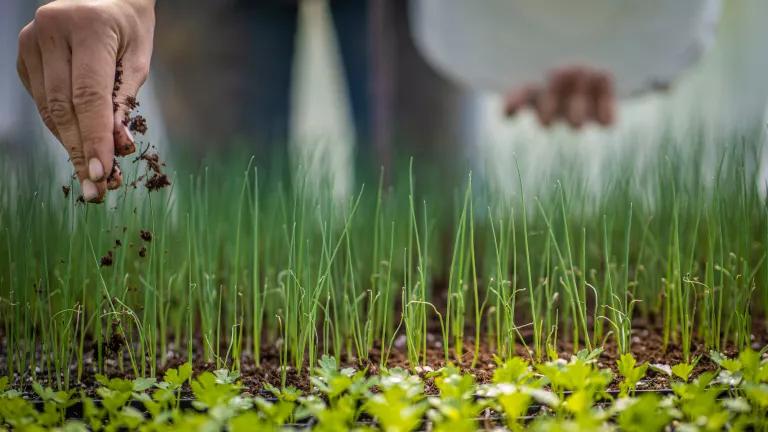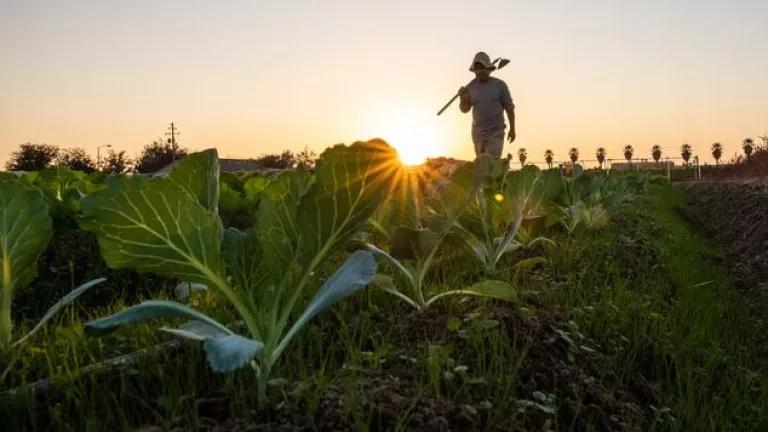
“Food and forage production will decline in regions experiencing increased frequency and duration of drought. Shifting precipitation patterns, when associated with high temperatures, will intensify wildfires that reduce forage on rangelands, accelerate the depletion of water supplies for irrigation, and expand the distribution and incidence of pests and diseases for crops and livestock.”
—National Climate Assessment
Declining crop yields. Crop loss due to drought, fire, and flood. Pest and disease outbreaks. Depleted groundwater supplies and degraded soil and water quality.
The National Climate Assessment (NCA) report released last week included all these evils and more in its grim forecast for American farmers. With our food supply at stake, it is a future we all share.
The NCA highlights the degradation of soil and water resources as one of the major threats climate change poses to agriculture.
“The degradation of critical soil and water resources will expand as extreme precipitation events increase across our agricultural landscape. Sustainable crop production is threatened by excessive runoff, leaching, and flooding, which results in soil erosion, degraded water quality in lakes and streams, and damage to rural community infrastructure. Management practices to restore soil structure and the hydrologic function of landscapes are essential for improving resilience to these challenges.”
—National Climate Assessment
Farmers in the US and across the world are already on the front lines of climate change, and undoubtedly have challenges ahead of them. But they also have the potential to be part of the climate change solution, and that solution is in the soil.
Restoring our soil is more than a helpful tool in our toolbox to fight climate change and water quality degradation—it is an essential task. The NCA highlights cover crops and crop rotations as a key practice to restore soil quality and help fight climate change.
Unfortunately, only a small percentage of our cropland is planted to cover crops—less than 3% according to the 2012 Census of Agriculture.
How Do Cover Crops Help Fight Climate Change?
If you know anything about cover crops, you probably know that they are great for improving soil health and water quality. Healthy soil stores more water, which makes farms more resilient to the impacts of extreme weather brought on by climate change. But did you know that cover crops can also help mitigate the greenhouse gas emissions that contribute to climate change?
NRDC asked consultant Noel Gurwick to research if and how cover crops can reduce greenhouse gas emissions. Dr. Gurwick’s 2016 analysis and literature review revealed the following ways cover crops impact greenhouse gas emissions from agriculture.Dr Gurwick's study identified 7 ways that cover crops can mitigate climate change, but as some had less positive impact than others or less connection with the soil, I have regrouped and focus on 3 pathways for this blog.
Increasing Soil Carbon Storage
Plants convert CO2 into organic matter through photosynthesis, so natural ecosystems like grasslands and forestland are incredibly important to mitigate climate change. Similarly, cover crops and practices that follow soil health principles have enormous potential to fight climate change - about 70% of cover crops greenhouse gas mitigation potential comes from soil carbon storage. While estimates of the exact potential emissions reductions vary in scientific literature, this is due to the uncertainty about the permanence of sequestered carbon due to factors we can't predict or control, like land management change. Farms need to be continually managed for soil health over the years to reach the full potential of soil carbon sequestration; if farms are plowed up or converted to urban development, the soil carbon benefits will be lost. Nevertheless, if all farms were managed to optimize soil health, then farmland has the potential to be a huge carbon sink.
Reducing Nitrous Oxide Emissions from Groundwater and Surface Water
Crops depend on nitrogen, and so farmers add nitrogen fertilizer to soil to make sure they will have healthy crop. Unfortunately, a lot of that nitrogen isn’t taken up by the crop and some of it washes away into surface and groundwater. Microbes can grab this nitrogen and produce nitrous oxide, a harmful greenhouse gas that can trap nearly 300 times more heat than CO2. Planting cover crops indirectly reduces nitrous oxide emissions by taking up the nitrogen through their roots, reducing the flow of water on the surface and increasing the infiltration of water (and nitrogen) into the soil.This means more opportunities for plants to trap nitrogen before it leaves the field where microbes in streams and aquifers can turn it into nitrous oxide.The end result is that planting cover crops reduces nitrous oxide emissions downstream, in streams and aquifers.
Just as excess nitrogen in groundwater and in streams can be converted to nitrous oxide, the same thing happens in soil on crop fields. However, cover crops do not systematically reduce emissions from fields as they do in groundwater and streams, for two reasons. First, cover crop roots stimulate microbes in the soil, meaning that more of the nitrogen that remains in the soil is converted to nitrous oxide. Second, some cover crops are legumes, which themselves add nitrogen to the soil. Dr. Gurwick’s research suggests that guidance targeted towards specific management practices might enable growers to reduce nitrous oxide emissions using cover crops, but concludes that in general cover crops neither increase nor decrease nitrous oxide emissions from farm fields.
Reducing Emissions from Fertilizer Production and Transport
While reduced fertilizer use following cover crops is not guaranteed, it stands to reason that if cover crops are taking up more nitrogen and reducing loss of nitrogen from the field into water supplies, or even fixing their own nitrogen from the air, that farmers will need to apply less fertilizer on their crops after planting cover crops. If farmers continuously improve soil health for several years, they can naturally fix more and more nitrogen in their soil and scale back application of synthetic nitrogen fertilizer. This natural fixation reduces the greenhouse gas emissions resulting from fertilizer production and transport as well as direct and indirect nitrous emissions.
Solution: Support Farmers with Soil and Climate-Friendly Agricultural Policy
The NCA points to crop insurance as a key policy to help farms adjust to climate change. But relying on the crop insurance program as the sole risk management strategy in a changing climate may actually increase risk for farmers over time—not to mention the rising costs incurred by the program. Currently, the Federal Crop Insurance Program (FCIP) treats climate-friendly farming just the same as the status quo, and this is a huge missed opportunity. We recommend that the FCIP reward farmers who use climate-friendly techniques with better crop insurance premiums. As it is now, the FCIP encourages farmers to be overly reliant on their crop insurance policies, without making adjustments to improve their soil for the perils of a changing climate.
At NRDC, we advocate for changes to our crop insurance program that will make it more climate friendly in the long run. You can read our paper, Covering Crops, for a full list of recommended reforms that are not mentioned in the NCA report. Some of these were included in the Senate version of the Farm Bill, and we are keeping our fingers crossed that Congress includes these innovative healthy soil policies in the imminent final version of the farm bill (read my blog here for a list of the healthy soil policies NRDC supported in the Senate bill). There is too much at risk to let another four years go by without shifting to a more holistic risk management strategy for farmers.
It’s not just up to farmers to make the change to regenerative, climate-friendly agriculture techniques; we all have a stake in the future of our farms. That’s why it’s so important to create policies that will drive change toward regenerative agricultural systems. Let’s help farmers be part of the solution to climate change, instead of setting them up to be the victims.
PS: Don't forget to celebrate World Soil Day on December 5th! Stay tuned for more from my colleagues...
UPDATE: The sections on soil carbon sequestration and emissions reduction were edited for clarity and accuracy on 8-02-2019. - Lara Bryant



